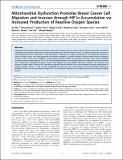| dc.contributor.author | Ma, Jia | en_US |
| dc.contributor.author | Zhang, Qing | en_US |
| dc.contributor.author | Chen, Sulian | en_US |
| dc.contributor.author | Fang, Binbin | en_US |
| dc.contributor.author | Yang, Qingling | en_US |
| dc.contributor.author | Chen, Changjie | en_US |
| dc.contributor.author | Miele, Lucio | en_US |
| dc.contributor.author | Sarkar, Fazlul H. | en_US |
| dc.contributor.author | Xia, Jun | en_US |
| dc.contributor.author | Wang, Zhiwei | en_US |
| dc.date.accessioned | 2014-03-01T02:25:29Z | |
| dc.date.issued | 2013 | en_US |
| dc.identifier.citation | Ma, Jia, Qing Zhang, Sulian Chen, Binbin Fang, Qingling Yang, Changjie Chen, Lucio Miele, Fazlul H. Sarkar, Jun Xia, and Zhiwei Wang. 2013. “Mitochondrial Dysfunction Promotes Breast Cancer Cell Migration and Invasion through HIF1α Accumulation via Increased Production of Reactive Oxygen Species.” PLoS ONE 8 (7): e69485. doi:10.1371/journal.pone.0069485. http://dx.doi.org/10.1371/journal.pone.0069485. | en |
| dc.identifier.issn | 1932-6203 | en |
| dc.identifier.uri | http://nrs.harvard.edu/urn-3:HUL.InstRepos:11855905 | |
| dc.description.abstract | Although mitochondrial dysfunction has been observed in various types of human cancer cells, the molecular mechanism underlying mitochondrial dysfunction mediated tumorigenesis remains largely elusive. To further explore the function of mitochondria and their involvement in the pathogenic mechanisms of cancer development, mitochondrial dysfunction clones of breast cancer cells were generated by rotenone treatment, a specific inhibitor of mitochondrial electron transport complex I. These clones were verified by mitochondrial respiratory defect measurement. Moreover, those clones exhibited increased reactive oxygen species (ROS), and showed higher migration and invasive behaviors compared with their parental cells. Furthermore, antioxidant N-acetyl cysteine, PEG-catalase, and mito-TEMPO effectively inhibited cell migration and invasion in these clones. Notably, ROS regulated malignant cellular behavior was in part mediated through upregulation of hypoxia-inducible factor-1 α and vascular endothelial growth factor. Our results suggest that mitochondrial dysfunction promotes cancer cell motility partly through HIF1α accumulation mediated via increased production of reactive oxygen species. | en |
| dc.language.iso | en_US | en |
| dc.publisher | Public Library of Science | en |
| dc.relation.isversionof | doi:10.1371/journal.pone.0069485 | en |
| dc.relation.hasversion | http://www.ncbi.nlm.nih.gov/pmc/articles/PMC3726697/pdf/ | en |
| dash.license | LAA | en_US |
| dc.subject | Biology | en |
| dc.subject | Biochemistry | en |
| dc.subject | Bioenergetics | en |
| dc.subject | Energy-Producing Organelles | en |
| dc.subject | Metabolism | en |
| dc.subject | Oxygen Metabolism | en |
| dc.subject | Medicine | en |
| dc.subject | Clinical Genetics | en |
| dc.subject | Mitochondrial Diseases | en |
| dc.subject | Oncology | en |
| dc.subject | Basic Cancer Research | en |
| dc.subject | Metastasis | en |
| dc.subject | Tumor Physiology | en |
| dc.subject | Cancers and Neoplasms | en |
| dc.subject | Breast Tumors | en |
| dc.subject | Invasive Ductal Carcinoma | en |
| dc.title | Mitochondrial Dysfunction Promotes Breast Cancer Cell Migration and Invasion through HIF1α Accumulation via Increased Production of Reactive Oxygen Species | en |
| dc.type | Journal Article | en_US |
| dc.description.version | Version of Record | en |
| dc.relation.journal | PLoS ONE | en |
| dc.date.available | 2014-03-01T02:25:29Z | |
| dc.identifier.doi | 10.1371/journal.pone.0069485 | * |
| dash.authorsordered | false | |


